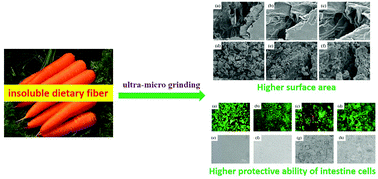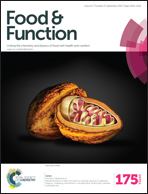Physicochemical properties and intestinal protective effect of ultra-micro ground insoluble dietary fibre from carrot pomace
Abstract
Carrot pomace is an abundant, but underutilized, byproduct from the juice industry. In this study, the insoluble dietary fiber from carrot pomace was treated using an ultra-microgrinding process, and the resulting changes in its physicochemical properties and intestinal protective effect against heavy metal damage were examined. The SEM and fluorescence microscopy results showed that the grinding process could significantly decrease the particle size of carrot insoluble dietary fibre and increase its Brunauer–Emmett–Teller surface area from 0.374 to 1.835 m2 g−1. Correspondingly, the water-holding capacity, swelling capacity, and oil-holding capacity increased by 62.09%, 49.25% and 45.45%, respectively. The glucose-, nitrite-, and lead ion-adsorbing abilities also improved significantly compared with the raw samples. In addition, apoptosis assessment by AO/EB revealed that the ground fibre could effectively protect Caco-2 cells from lead ion damage. The MTT assay showed that carrot insoluble dietary fibre has no toxicity for Caco-2 cells at a concentration of 10.0 mg L−1. The findings of this study highlighted the potential of the ultra-microgrinding process to produce a high added-value fibre ingredient from carrot residues.


 Please wait while we load your content...
Please wait while we load your content...